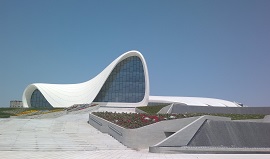Main author
Michael BrooksThe Architecture of Neoliberalism
Douglas Spencer - ‘The Architecture of Neoliberalism: How contemporary architecture became an instrument of control and compliance’
Published by Bloomsbury Academic (2016)
When Zaha Hadid died in 2016, she was celebrated as one of the 21st century’s most influential and visionary architects. Buildings such as the Guangzhou Opera House, the London Aquatics Centre, and the Heydar Aliyev Cultural Centre demonstrated a radical and futuristic aesthetic that was very much her own.
However, her critics also made mention of the human rights controversies which dogged her later career; in particular, the building of the Qatar World Cup Stadium, for which she claimed an abdication of responsibility.
More recently, Hadid’s successor, Patrick Schumacher, attracted considerable opprobrium when he advocated untrammelled gentrification and the privatisation of all social housing and public space, including Hyde Park.
According to Douglas Spencer, such pronouncements and controversies, far from being isolated events, are very much bound up in the architecture of neoliberalism that has developed over the last couple of decades, and which he critiques in his challenging and uncompromising book.
Neoliberalism is one of those buzzwords that is often used but seldom completely understood. In short it is a form of capitalism that promotes shrinking the state and public services in favour of privatisation, and any notion of the 'common good' is surrendered to the ‘logic of the market'. It was developed as an ideology by the likes of Hayek and Friedman, and introduced in the West by Thatcher and Reagan in the 1980s.
Spencer’s book is perhaps the first to analyse neoliberalism in conjunction with its architectural expressions. He joins the intellectual dots from 20th century countercultural thinkers such as Foucault and Lefevre, to some of the 21st century’s most celebrated architectural practices. In addition to Hadid and Schumacher, the book provides incisive analysis of the likes of Rem Koolhaas, Alejandro Zaera-Polo and Greg Lynn, and deconstructs buildings such as the CCTV Headquarters in Beijing, Birmingham New Street station, and the BMW factory in Leipzig.
Overall, this is a complex and tough read, which will likely only appeal to those steeped in architectural theory and criticism. But that does not make the book any less important or timely. Indeed at this disorientating time of change, when the foundations of the neoliberal ideology appear to be buckling beneath the weight demonstrable failures, it is a powerful and instructive piece of work.
To find out more and purchase the book click here.
[edit] Find out more
[edit] Related articles on Designing Buildings Wiki
- Charles Waldheim - Landscape as Urbanism: A General Theory.
- Interview with Tom Dyckhoff.
- Last Futures: Nature, Technology and the End of Architecture.
- Living in the hyperreal post-modern city.
- Neo-futurism.
- Public space intervention.
- Owen Hatherley - Landscapes of Communism.
- The architectural profession.
- Zaha Hadid.
Featured articles and news
Homes England creates largest housing-led site in the North
Successful, 34 hectare land acquisition with the residential allocation now completed.
Scottish apprenticeship training proposals
General support although better accountability and transparency is sought.
The history of building regulations
A story of belated action in response to crisis.
Moisture, fire safety and emerging trends in living walls
How wet is your wall?
Current policy explained and newly published consultation by the UK and Welsh Governments.
British architecture 1919–39. Book review.
Conservation of listed prefabs in Moseley.
Energy industry calls for urgent reform.
Heritage staff wellbeing at work survey.
A five minute introduction.
50th Golden anniversary ECA Edmundson apprentice award
Showcasing the very best electrotechnical and engineering services for half a century.
Welsh government consults on HRBs and reg changes
Seeking feedback on a new regulatory regime and a broad range of issues.
CIOB Client Guide (2nd edition) March 2025
Free download covering statutory dutyholder roles under the Building Safety Act and much more.
Minister quizzed, as responsibility transfers to MHCLG and BSR publishes new building control guidance.
UK environmental regulations reform 2025
Amid wider new approaches to ensure regulators and regulation support growth.
BSRIA Statutory Compliance Inspection Checklist
BG80/2025 now significantly updated to include requirements related to important changes in legislation.

























